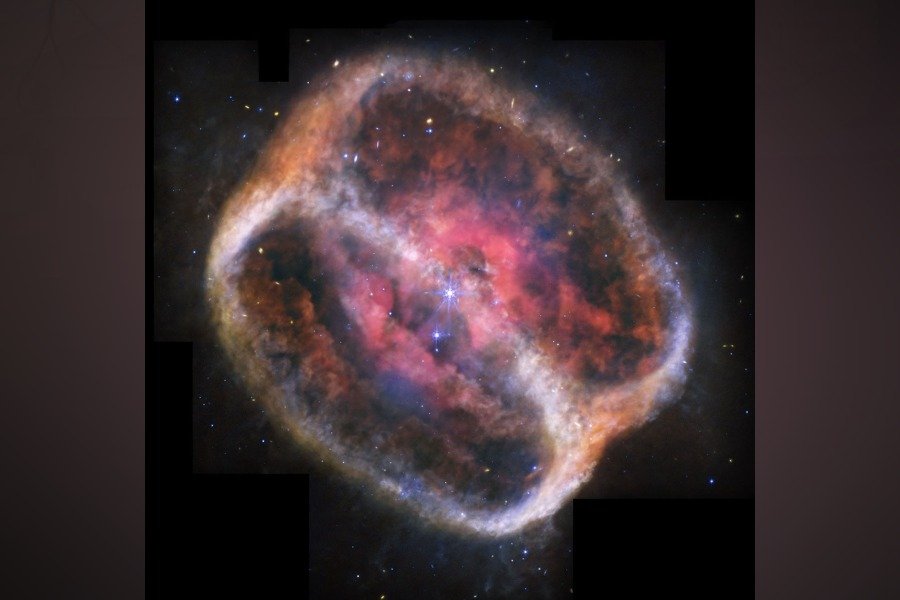In a groundbreaking revelation, the James Webb telescope has once again astonished astronomers by capturing a stunning image of a young star forming in deep space — and the results are nothing short of mesmerizing. This latest image, which vividly resembles an hourglass, offers a rare and unprecedented glimpse into the earliest stages of a star’s birth.

Table of Contents
A Celestial Spectacle Captured in Infrared
The James Webb telescope, operated by NASA in collaboration with ESA and CSA, has delivered one of its most iconic images yet. What appears to be an ethereal hourglass in space is, in fact, a protostar designated L1527, situated in the Taurus star-forming region, approximately 460 light-years from Earth.
Key Highlights:
- Infrared imaging revealed swirling clouds of gas and dust around the forming star.
- The structure mimics an hourglass due to light escaping from the protostar.
- These emissions are only visible in the infrared spectrum, a specialty of the James Webb telescope.
Understanding the Formation of Stars
This striking image goes beyond aesthetic appeal — it offers valuable scientific insights into how stars are born and evolve in the early universe.
Features of the Protostar L1527:
- It is still embedded within a thick cloud of gas and dust, which feeds material to the star.
- The light from the protostar escapes above and below the disk, illuminating the surrounding matter in a symmetric, hourglass-like shape.
- The dark band in the center represents the dense protoplanetary disk that may eventually give rise to planets.
The Role of the James Webb Telescope in Stellar Discoveries
The James Webb telescope is uniquely capable of capturing such intricate cosmic phenomena due to its infrared technology. Unlike previous telescopes, Webb can peer through dust clouds that typically obscure newly forming stars.
What Makes the James Webb Telescope Ideal for This?
- High-resolution infrared imaging that pierces dense space matter.
- Operates far beyond Earth’s orbit, minimizing distortion from our atmosphere.
- Equipped with Near-Infrared Camera (NIRCam) and Mid-Infrared Instrument (MIRI) to detect faint, early-stage objects in space.
Hourglass Shape Explained: What Does It Mean?
The hourglass shape seen in the latest image is not just a visual marvel — it’s a direct result of stellar formation mechanics.
Why It Looks Like an Hourglass:
- Jets of gas emitted from the star push surrounding material outward.
- These jets carve out cavities above and below the protoplanetary disk.
- The escaping light illuminates these cavities, creating the symmetrical hourglass effect.
What This Means for Future Exploration
The latest image reinforces the James Webb telescope‘s role as a revolutionary tool in modern astronomy. By unveiling cosmic events hidden behind veils of dust, Webb offers a front-row seat to the birth of stars and planets, helping scientists better understand the early universe.
Implications for Astronomy:
- Helps researchers model how stars form from collapsing gas clouds.
- Assists in identifying the early conditions needed for planet formation.
- Opens up new avenues to explore life-supporting systems in distant galaxies.
Conclusion: James Webb Telescope Redefines Space Observation
The unveiling of the hourglass-shaped protostar is not just a testament to modern engineering, but a transformative moment in our understanding of the cosmos. With each image, the James Webb telescope continues to redefine the boundaries of space exploration, shining light — quite literally — on the mysteries of the universe.
As scientists continue to analyze this and future discoveries, one thing remains clear: the James Webb telescope is more than a tool — it is humanity’s window into the past, present, and future of the cosmos.
🔭 For more science, space, and tech news, visit Hours of News

